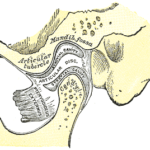
Temporomandibular joint (TMJ) arthralgia is a painful condition that is often managed with local measure such as occlusal splints, manipulation of the mandible and jaw exercise. Nonsteroidal analgesia and other conventional analgesics are also commonly used although for persistent pain intra-articular injection of corticosteroids can be used. While corticosteroids have been used the need for more primary studies has been highlighted.
The aim of this study was to assess the efficacy of a single-dose intra-articular injection of methylprednisolone to reduce TMJ pain.
Methods
Patients aged 18 or older who had been diagnosed with unilateral TMJ arthralgia were randomised to receive either a single 1 mL IA injection of either methylprednisolone 40mg/mL) or saline following an auriculotemporal nerve block with 1.8 mL of prilocaine- felypressin 30 + 0.54 mg/mL. Patients were prescribed rescue analgesia recording usage in the diary provided.
The primary outcome measure was change in visual analogue scale (VAS)-rated pain at maximum opening. Baseline assessments was undertaken immediately prior to the intervention and at 4 weeks. The 20-item global Jaw Functional Limitation Scale (JFLS- 20), and the Patient Health Questionnaire-9 (PHQ-9) were also administered at both time points. Patients also Participants rated the change in their overall status since beginning the study treatment using the Patient Global Impression of Change (PGIC
Results
- 54 patients were randomised 27 to each group.
- 2 patients in the saline group were withdrawn.
- Between baseline and the 4-week follow-up, VAS-rated pain intensity at maximum jaw opening decreased in both groups with no significant difference between the groups (P = 0.812).
| VAS-rated pain intensity | Methylprednisolone
Mean (95%CI) |
Saline
Mean (95%CI) |
| Baseline | 61.0 (50.1; 70.7) | 59.6 (50.7; 65.9) |
| 4 weeks | 33.9 (21.6; 46.2) | 33.9 (23.8; 43.9) |
- There was a significant improvement in JFLS-20 Jaw function evaluation in both groups but no significant between-group differences
- 29% of patients in the methylprednisolone group and 35% in the saline group were taking analgesic the day before the intervention. Analgesic use doubled in the methylprednisolone group the day after the intervention. There was no change in the saline group.
- There were more adverse events in the methylprednisolone group (17) compared with the Saline group (7).
Conclusions
The authors concluded: –
our findings show that methylprednisolone was not superior to saline for reducing TMJ arthralgia pain. On the contrary, methylprednisolone caused greater pain compared with saline following the intervention. The combination of a nerve block with local anaesthetics and an IA deposition of saline provided substantial improvements in pain. The mechanism behind this phenomenon requires further evaluation.
Comments
While this trial is been well conducted and reported it may be lacking in power. The power calculation was based on the assumption of 15-mm VAS as a clinically meaningful difference with a requirement to recruit 32 patients per group. Despite a prolonged recruitment period Dec 2013 to Feb 2017 only 27 patients per arm could be recruited. further studies are required to confirm these findings.
Links
Primary Paper
Isacsson G, Schumann M, Nohlert E, Mejersjö C, Tegelberg Å. Pain relief following a single-dose intra-articular injection of methylprednisolone in the temporomandibular joint arthralgia-A multicentre randomised controlled trial. J Oral Rehabil. 2019 Jan;46(1):5-13. doi: 10.1111/joor.12718. Epub 2018 Oct 10.PubMed PMID: 30240024.
Other references
Dental Elf – Temporomandibular Joint Disorder blogs
Picture Credits
